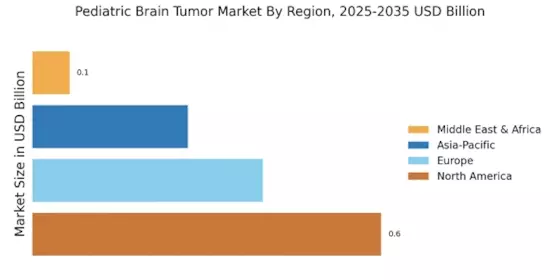Growing Incidence of Pediatric Brain Tumors
The rising incidence of pediatric brain tumors appears to be a primary driver for the Pediatric Brain Tumor Market. Recent statistics indicate that brain tumors are the most common solid tumors in children, accounting for approximately 20% of all pediatric cancers. This increasing prevalence necessitates enhanced treatment options and diagnostic tools, thereby propelling market growth. As awareness of these tumors expands, more children are diagnosed, leading to a greater demand for innovative therapies and supportive care. The Pediatric Brain Tumor Market is likely to experience significant growth as healthcare providers seek to address this urgent need, potentially leading to advancements in treatment modalities and improved patient outcomes.
Increased Funding for Pediatric Cancer Research
Increased funding for pediatric cancer research is a significant driver for the Pediatric Brain Tumor Market. Various governmental and non-governmental organizations are allocating substantial resources to advance research initiatives aimed at understanding the biology of pediatric brain tumors. This influx of funding is likely to facilitate the development of novel therapies and improve existing treatment protocols. For example, initiatives such as the National Cancer Institute's research grants are instrumental in fostering innovation in this field. As research progresses, the Pediatric Brain Tumor Market may witness a surge in new treatment options, ultimately benefiting patients and healthcare providers alike.
Technological Advancements in Treatment Modalities
Technological advancements in treatment modalities are transforming the Pediatric Brain Tumor Market. Innovations such as targeted therapies, immunotherapy, and minimally invasive surgical techniques are emerging as effective alternatives to traditional treatments. For instance, the introduction of proton therapy has shown promise in reducing radiation exposure to healthy tissues, which is particularly crucial in pediatric patients. The market is projected to expand as these advanced treatment options become more widely available, enhancing the quality of care for young patients. Furthermore, the integration of artificial intelligence in treatment planning and monitoring may streamline processes, potentially leading to better clinical outcomes and increased market demand.
Emerging Markets and Expanding Healthcare Infrastructure
Emerging markets with expanding healthcare infrastructure are poised to influence the Pediatric Brain Tumor Market positively. As countries develop their healthcare systems, access to advanced medical technologies and treatment options is improving. This trend is particularly evident in regions where investments in healthcare are increasing, leading to better diagnostic and therapeutic capabilities for pediatric brain tumors. The market may experience growth as healthcare providers in these regions adopt innovative treatment modalities and enhance patient care. Furthermore, collaborations between local and international organizations could facilitate knowledge transfer and resource sharing, ultimately benefiting the Pediatric Brain Tumor Market.
Rising Awareness and Advocacy for Pediatric Brain Tumors
Rising awareness and advocacy for pediatric brain tumors are contributing to the growth of the Pediatric Brain Tumor Market. Advocacy groups and organizations are actively working to educate the public about the signs and symptoms of brain tumors in children, which may lead to earlier diagnosis and treatment. This heightened awareness is likely to drive demand for diagnostic tools and treatment options, as parents and caregivers become more informed about available resources. Additionally, increased media coverage and community events focused on pediatric brain tumors are fostering a supportive environment for affected families, further propelling market growth as stakeholders seek to address these critical health issues.


















Leave a Comment